Dragons come in all shapes and sizes, and run the gamut when it comes to personality, philosophy, civility, and attitude toward humans. Beowulf, Siegfried, and Saint George all killed dragons; so did Cadmus, the prince of Greek mythology, who planted the dragon’s teeth, from which sprang up a race of fierce warriors.
Famous dragons include Smaug, the greedy dragon of J.R.R. Tolkien’s The Hobbit, Falkor the Luck Dragon of Michael Ende’s Neverending Story, and Norbert, Hagrid’s obstreperous (and illegal) pet in J.K. Rowling’s Harry Potter and the Sorceror’s Stone. In C.S. Lewis’s Voyage of the Dawn Treader in the Chronicles of Narnia series, the obnoxious Eustace Scrubb is turned into a dragon and emerges from the experience a wiser, better boy.
Investigating dragons is fun anytime – but it’s particularly appropriate on April 23rd. Which is St. George’s Day.
Table of Contents
THE DRAGON OF LONELY ISLAND
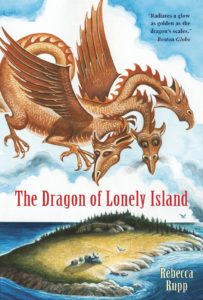
|
In The Dragon of Lonely Island (Candlewick, 1998), three children – Hannah, Zachary, and Sarah Emily – spend the summer on Lonely Island off the coast of Maine where, with the help of a mysterious map, they discover a wonderful golden three-headed dragon. The dragon tells them three magical tales from its past – one set in ancient China, one about a boy on board a pirate ship, and the last about two children who must survive on a desert island after a plane crash. For ages 6-11. |
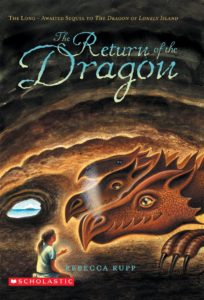
|
In a sequel, Return of the Dragon (Candlewick, 2005), the children return to the island where, through the dragon’s stories, they visit ancient Greece, a castle in the Middle Ages, and a southern plantation in the days before the Civil War, learning lessons along the way. They also solve a mystery and struggle to protect the dragon from a terrible danger. For ages 6-11. |
DRAGON TALES
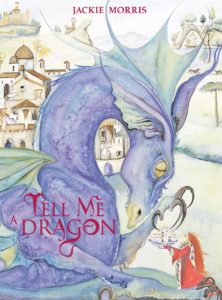
|
Jackie Morris’s Tell Me a Dragon (Frances Lincoln Children’s Books, 2009) is an exquisitely illustrated collection of dragons, from the huge to the tiny: “My dragon is made from the sun and the stars.” “My dragon is snaggle-toothed, fierce and brave.” (On the cover, a glorious lavender dragon plucks a cupcake from a platter.) The book ends with “Tell me about your dragon.” For ages 4 and up. |
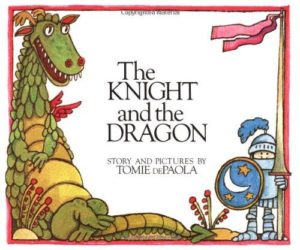
|
In Tomie de Paola’s The Knight and the Dragon (Putnam Publishing Group, 1980), both knight and dragon realize that they’re supposed to fight – but neither knows how to go about it. They do their best to find out (the knight resorts to the castle library; the dragon delves through his ancestor’s artifacts) – but with the help of a canny princess, they eventually realize that they’re better off just being themselves. For ages 4-8. |
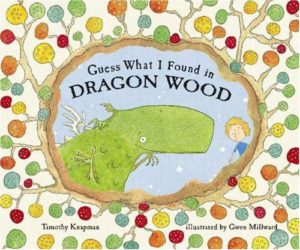
|
In Timothy Knapman’s Guess What I Found in Dragon Wood (Bloomsbury USA, 2007), an excited young dragon finds a Benjamin – a goggle-eyed little boy in striped boots – in the woods and brings him home to keep as a pet. For ages 4-8. |
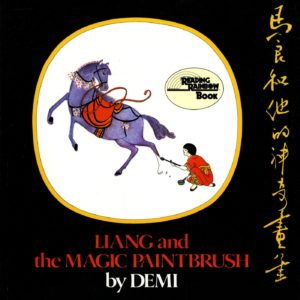 |
In Demi’s exquisitely illustrated Liang and the Magic Paintbrush (Henry Holt, 1988), everything that Liang paints with his magical paintbrush comes alive. When confronted with an evil emperor, Liang paints a dragon. For ages 4-8. |
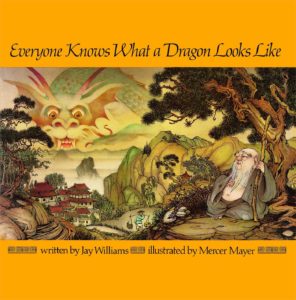
|
In Jay Williams’s lovely picture book Everyone Knows What a Dragon Looks Like (Aladdin, 1980), it turns out that everyone doesn’t. Only the little orphan boy Han believes that a dragon could look like a little fat old man. For ages 4-8. |
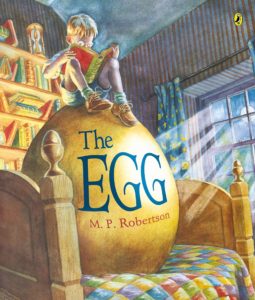
|
In M.P. Robertson’s The Egg (Puffin, 2004), George discovers an enormous golden-brown egg in the family henhouse from which hatches a baby dragon. Even though George doesn’t speak Dragon, he manages to “teach the dragon dragony ways,” and help it find its way home. The illustrations are wonderful: one painting shows the armchair-sized egg perched on George’s quilt-covered bed, while George sits on top of it, reading. For ages 4-8. |
| George’s dragon returns for another adventure in The Great Dragon Rescue (Frances Lincoln Books, 2009). | |
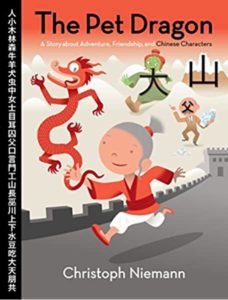 |
Christoph Niemann’s The Pet Dragon (Greenwillow Books, 2008) is a clever introduction to Chinese characters through the story of a little girl, Lin, who receives a little red dragon as a present. The characters are integrated into the pictures, which works as a memory aid. For ages 4-8. |
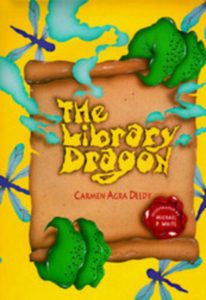
|
In Carmen Agra Deedy’s The Library Dragon (Peachtree Publishers, 1994), Sunrise Elementary School’s new librarian is a dragon – who refuses to let children (with their sticky little fingers) near the library books. Nothing will convince her otherwise, until a myopic little girl wanders into the library and begins reading a story about a dragon out loud. Children gather to listen and the library dragon has a change of heart. For ages 4-8. |
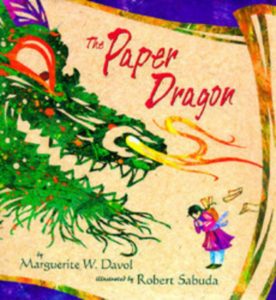
|
Mi Fei, a humble scroll painter, is the hero of Marguerite W. Davol’s The Paper Dragon (Atheneum Books for Young Readers, 1997). When the terrible dragon Sui Jen awakes from his long sleep and begins trampling rice fields and destroying villages, Mi Fei goes out to stop him. The dragon strikes a bargain, challenging Mi Fei to bring him fire, wind, and the strongest thing in the world – all wrapped in paper. Mi Fei responds with a paper lantern, a paper fan, and a paper painting of all the people in his village – since the strongest thing in the world is love. Naturally he saves the day. Illustrated with lovely tissue-paper collages by Robert Sabuda. For ages 4-9. |
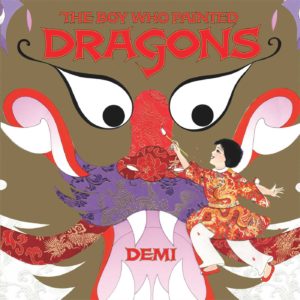
|
Gorgeous gold, red, and purple Chinese dragons fill Demi’s The Boy Who Painted Dragons (Margaret K. McElderry Books, 2007). The painter, young Ping, is visited by the Heavenly Dragon, who discovers that the painted dragons really represent Ping’s fears. He gives the boy three pearls of wisdom, which he can only earn by confronting four dragons: Water Dragon, Fire Dragon, Earth Dragon, and Wind Dragon. For ages 5-9. |
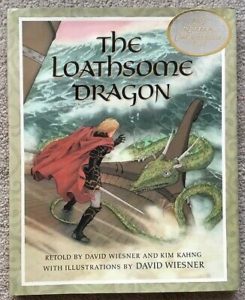
|
Caldecott winner David Wiesner’s The Loathsome Dragon (Clarion Books, 2005) is a retelling of a traditional English fairytale in which a widowed king falls in love with a wicked enchantress, who – jealous – turns his lovely daughter, the Princess Margaret, into a terrible dragon. Margaret’s brother Richard eventually manages to reverse the spell and – with the help of a magic rowan twig – the enchantress is turned into a Loathsome Toad. For ages 5-9. |
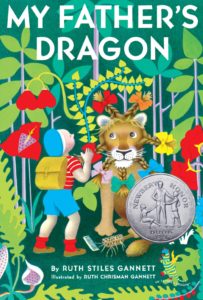
|
In Ruth Stiles Gannett’s My Father’s Dragon (Alfred A. Knopf, 1988) (a Newbery Award winner from 1948), the animals of Wild Island have captured a baby dragon and young Elmer Elevator, with a knapsack full of lollipops and hair ribbons, sets off to rescue it. Sequels are Elmer and the Dragon and The Dragons of Blueland. For ages 5-10. |
| Read My Father’s Dragon online. | |
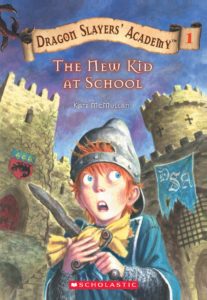
|
Kate McMullen’s Dragon Slayers’ Academy series begins with The New Kid at School (Grosset & Dunlap, 2003) in which carroty-headed Wiglaf, the smallest and most put-upon of an enormous peasant family, has his fortune told by a traveling minstrel and finds that he is destined to be a hero. Off he goes with his pet pig Daisy to the Dragon Slayers’ Academy to learn his future trade – despite the fact that he can’t stand the sight of blood. Many sequels, all with the same slapsticky humor. For ages 6-10. |
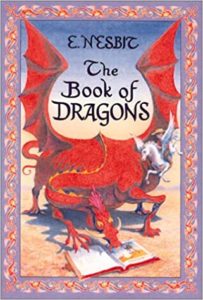 |
Edith Nesbit’s The Book of Dragons (Random House Books for Young Readers, 2010), originally published in 1900, is a wonderful collection of eight dragon tales, among them “The Book of Beasts,” “The Deliverers of Their Country,” and “Uncle James, or the Purple Stranger.” For ages 8-12. |
| Nesbit’s Book of Dragons is online here. |
|
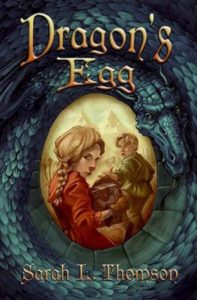
|
In Sarah L. Thomson’s Dragon’s Egg (Greenwillow Books, 2007), young Mella is a dragonkeeper – but the dragons she tends are small friendly farm animals, not the fire-breathing monsters of the old myths. Then Mella comes upon a dragon’s egg in the forest, guarded by a truly terrifying dragon – and with the help of Roger, a squire to a Knight of the Order of Defenders, sets out to transport it safely to the ancestral Hatching Grounds. For ages 8-12. |
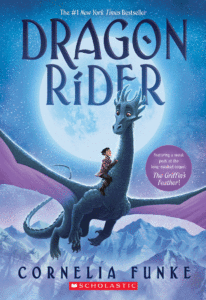 |
Cornelia Funke’s Dragon Rider (Chicken House, 2011) features an orphan boy, a feisty brownie, a brave young dragon, and a quest to return the dragons to their ancestral home – in the teeth of multitudinous enemies, among them the vicious dragon-exterminating Nettlebrand. For ages 8-12. |
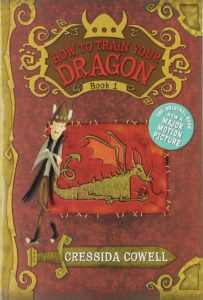 |
Cressida Cowell’s How to Train Your Dragon (Little, Brown Books for Young Readers, 2010) is the first of a humorous series starring the hapless young Viking Hiccup Horrendous Haddock III who – as a warrior-in-training – must (somehow) capture and train a dragon. Many sequels. For ages 8-12. |
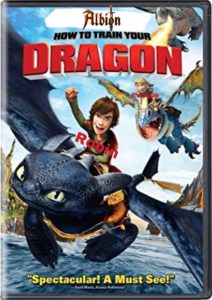 |
The 2010 movie version of How to Train Your Dragon is rated PG. Also see How to Train Your Dragon: The Hidden World (2019). |
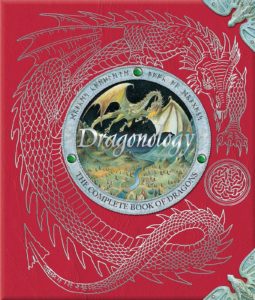
|
Dragonology by Ernest Drake and Duglad Steer (Candlewick, 2003) is a purported nonfiction guide to dragons by 19th-century “dragonologist” Ernest Drake. Included are explanations of the taxonomy and anatomy of dragons (with diagrams), a dragon alphabet, instructions for tracking and taming dragons, and a fold-out map of “Dragons of the World.” For ages 8 and up. |
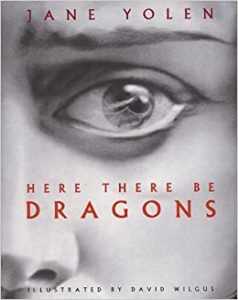 |
Jane Yolen’s Here There Be Dragons (Harcourt Childrens Books, 1993) is a collection of poems and stories about dragons from a range of genres for ages 9 and up.
Also see Yolen’s Here There Be Witches and Here There Be Unicorns.
|
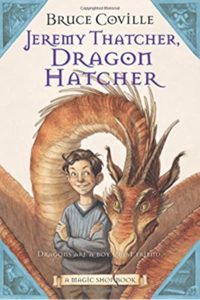
|
In Bruce Coville’s Jeremy Thatcher, Dragon Hatcher (Sandpiper, 2007), Jeremy stumbles into a mysterious shop and comes home with an egg from which hatches a tiny dragon, Tiamat, visible only to Jeremy and his nemesis, Mary Lou Hutton. With the help of Tiamat, Jeremy gains confidence and perspective – which survive even after Tiamat returns to her own world, where she belongs. For ages 9-12. |
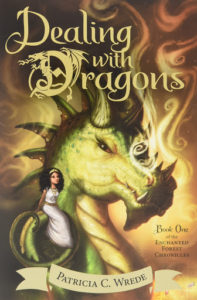
|
Patricia Wrede’s four-book Enchanted Forest Chronicles series begins with Dealing with Dragons (Sandpiper, 2002), in which the strong-minded Princess Cimorene, who prefers fencing to embroidery, deals with wizards, witches, and an enchanted stone prince, and finally ends up as Chief Cook and Librarian to Kazul, the (female) King of the Dragons. Sequels are Searching for Dragons, Calling on Dragons, and Talking to Dragons. For ages 9-12. |
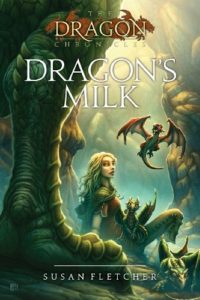 |
In Susan Fletcher’s Dragon’s Milk (Aladdin, 1996), Kaeldra’s little sister is dying of vermilion fever, for which the only cure is dragon’s milk. Kaeldra sets out to find some and ends up saving a litter of draclings. Sequels are Flight of the Dragon Kyn and The Sign of the Dove. For ages 9-12. |
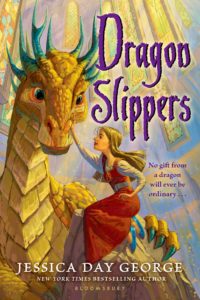
|
In Jessica Day George’s Dragon Slippers (Bloomsbury USA, 2008), Creel’s aunt – she’s not evil, just “dumber than two turnips in a rain barrel” – sends Creel to the dragon in hopes that a wealthy knight will rescue and marry her. Instead Creel makes friends with the dragon, who gives her a strange pair of blue shoes. Wearing them, she travels to the city to work as a seamstress – Creel is a talented embroiderer – where the plot thickens and Creel’s slippers turn out to hold the key to saving both the kingdom and its resident dragons. Sequels are Dragon Flight and Dragon Spear. For ages 10 and up. |
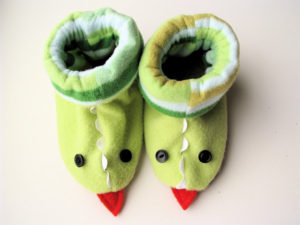  |
Dragon Slippers has a pattern and tutorial for making your own dragon slippers. |
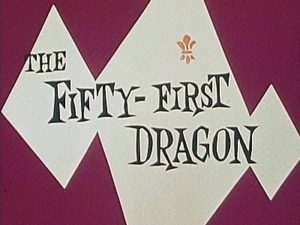
|
In Heywood Broun’s The Fifty-First Dragon, originally published in 1919, Gawaine le Coeur-Hardy – one of the least promising pupils at knight school – is given a magic word that allows him to kill fifty dragons. Then he discovers that the magic word is a fake. It all makes for some great discussions. For ages 11 and up. |
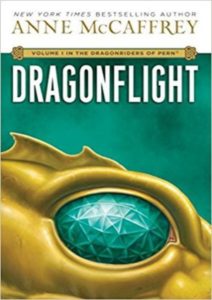
|
Anne McCaffrey’s Dragonriders of Pern series began in 1968 with Dragonflight, and now comprises some 22 volumes, and any number of Pern-related supplements. The planet of Pern, every 200 years, is endangered by the fall of Thread, silvery filaments that destroy everything they touch. To combat the Thread, a new breed of the native dragons has been developed – capable of burning the Thread out of the sky before it touches down and of bonding telepathically to a chosen human partner, the dragonrider. For ages 1s and up. |
| See Sariel’s Guide to Pern for a chronological book list and background information. | |
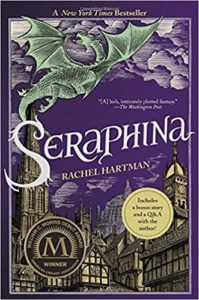 |
The setting of Rachel Hartman’s Seraphina (Ember, 2014) is a world where dragons and humans live (uneasily)side by side – and dragons can take human form. Then the crown prince is murdered, anti-dragon sentiment is on the rise, and musician Seraphina, half-human and half-dragon, is suddenly plunged into a central role. A wonderful, complex, and out-of-the-ordinary dragon tale for ages 12 and up. |
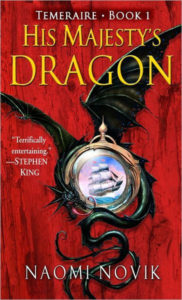 |
Naomi Novik’s His Majesty’s Dragon (Del Rey, 2006) is set during an alternative version of the Napoleonic Wars. Captain Will Lawrence of the King’s Navy captures a French ship carrying a dragon’s egg – and when the new hatchling imprints itself on him, he decides to join Britain’s fleet of dragon-borne aviators as master of the dragon Temeraire. First of a series for teens and adults. |
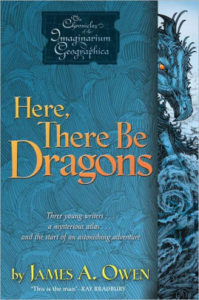 |
In James A. Owen’s Here, There Be Dragons (Simon & Schuster, 2007), set during World War I, three Oxford scholars are brought together in London by a murder – and by a peculiar little man who tells them that they are now the caretakers of the Imaginarium Geographica, an atlas of mythical lands, which can only be reached via the ship Indigo Dragon. And there are dragons. Fantasy, mystery, and danger for teens and adults |
| According to this article, no old maps actually say “Here there be dragons.” But there’s an ancient globe that does. | |
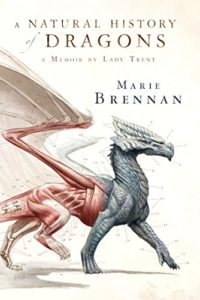 |
By Marie Brennan, A Natural History of Dragons (Tor Books, 2014) purports to be a memoir by Victorian aristocrat Isabella, Lady Trent, the world’s foremost dragon naturalist. The first of a series for teens and adults. |
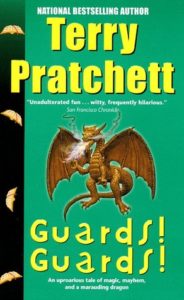 |
In Terry Pratchett’s Guards! Guards! (HarperCollins, 2009), one of the wonderful, hilarious, (and enormous) Discworld series, a marauding dragon has appeared in Discworld’s greatest city and has managed to get itself crowned king. Now it wants gold and virgins.To the rescue: the stunningly incompetent Night Watch. For teens and adults. |
